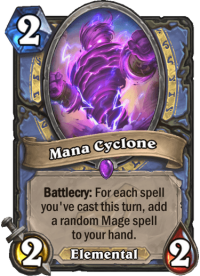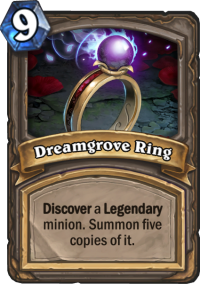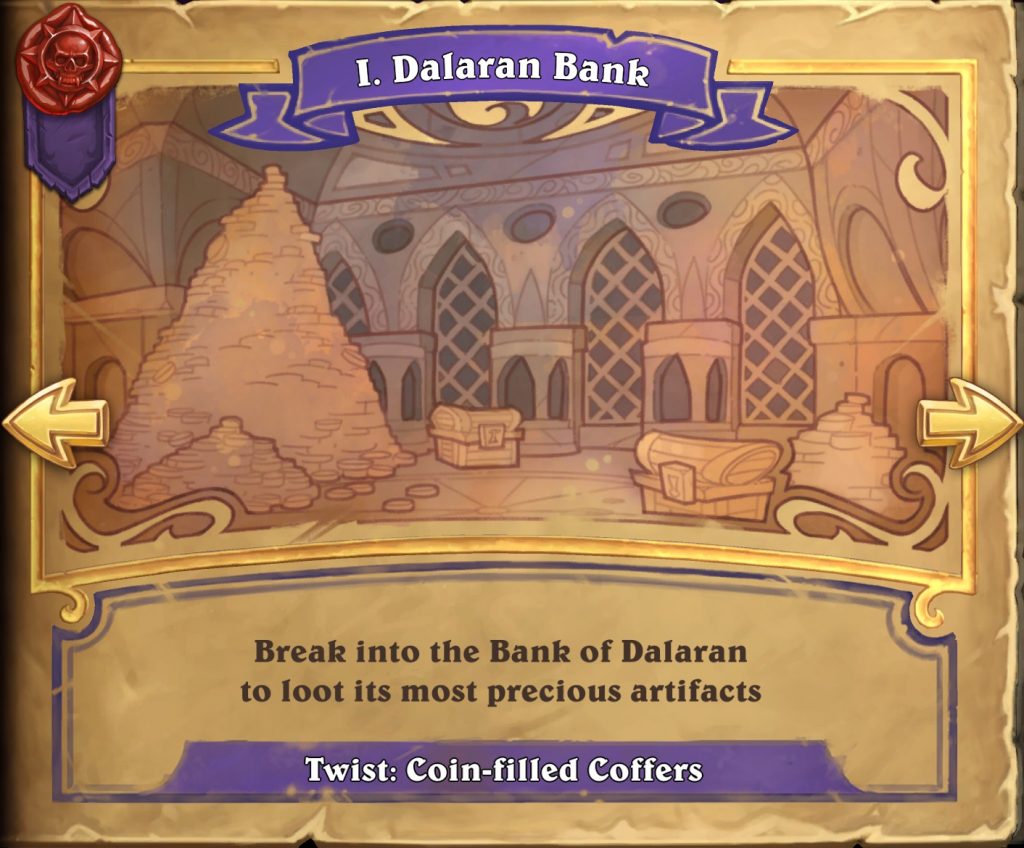The Dalaran Heist is out! It’s the biggest and most ambitious single player content Hearthstone ever had. And at the same time, it manages to be one of the most challenging ones. Or, to be more precise, most challenging one when you’re playing in Heroic mode. After spending long hours grinding the first chapter on both difficulties, I have to say that the balance is great. Casual players should not struggle in Normal mode, but they will still have to work for their wins. Veteran players should breeze through the Normal mode, but then Heroic mode will be a real challenge for them – something that was missing from the previous Hearthstone’s roguelike adventures.
First chapter of The Dalaran Heist takes us on a journey with King Togwaggle. As the chapters’ name suggests, we’re going to rob the Dalaran Bank. Of course, it won’t be an easy task – especially not on Heroic mode. With eight bosses standing between you and the treasure, each more difficult, you will have to show some serious deck building skills, but also take advantage of the chapter’s little twist.
Check Out Our Other Guides!
- The Dalaran Heist General Guide
- The Dalaran Heist Heroic Bosses Guide
- Chapter 2: The Violet Hold (Heroic Strategy)
- Chapter 3: Streets of Dalaran (Heroic Strategy)
- Chapter 4: The Underbelly (Heroic Strategy)
- Chapter 5: Kirin Tor Citadel (Heroic Strategy)
Twist: Coin-filled Coffers
Each of The Dalaran Heist chapters has its own so-called “Twist”. To put it simply, it’s a mechanic, which makes the chapter stand out and bring part of the story into actual gameplay. It’s also something you need to take into account when building your deck and playing it – especially when we’re talking about Heroic format.
In the first chapter, the twist is “Coin-filled Coffers”. After all, we’re robbing a bank. The effect is very simple – at the start of each game, Cache of Cash is spawned on the opponent’s side of the board. After it’s destroyed, both players get two Coins. Wait a minute, both players? So why would you want to do it? Since the effect is mirrored, both of you get the same advantage – not to mention that you also had to spend 3 points of damage to kill it. So maybe it’s just better to leave those alone? Actually, there are many cases in which that’s true – but not exactly for the reason I’ve just mentioned.
Strategy Guide
In this section, I’ll dive deeper into the general strategy when going into Chapter 1. If you’re looking for specific boss guides, click here.
When talking about Chapter 1 strategy, we’re mostly talking about Cache of Cash. It’s there in every single match, and you just can’t avoid it. And what you end up doing with it makes a huge difference. Which means that next I’ll try to answer the most important question – to break it or not to break it?
Deck Building
Whether you want to break cache or not starts even before the match – during deck building. To put it simply – you want to break cache if you will get more of it than your opponent, if it will create some sort of advantage. And that’s why you want to draft exactly towards that. Of course, some classes can do that better than others, but there are always some choices.

The biggest reason to break it are spell synergies. And when it comes to those, Mage is always your best bet. Luckily, it’s also the Hero you get to play with during the first Chapter even if you don’t plan to but subsequent ones. When playing Mage in Chapter 1, you want to prioritize cards that work well with spells. If you manage to pick cards such as Mana Wyrm, Mana Cyclone, Magic Dart Frog, Flamewaker, Vex Crow, or maybe even Archmage Antonidas, those two extra coins will come really handy. While we’re talking about Mage, Stargazer Luna is also a powerful pick in Chapter 1. Not only you can draw a card off one of the Coins, but since you have extra mana, the chances that you will get a longer draw streak are higher because of extra mana.
Another good example of being able to utilize the extra Coins well are Combo cards in Rogue (the class is not available yet, but it will be when Chapter 3 comes out). Those are stronger than their Battlecry counterparts, but also harder to activate, since you need to play another card before. Normally it’s very difficult to make them work on curve, but Coins make that much easier. Even better – with Coins, you can activate combo cards ahead of the curve. Dropping that Vilespine Slayer on Turn 4 after your opponent played a big minion is a huge tempo play and can turn the tides of a match. So if you end up playing Rogue in Chapter 1, you might want to pick even more Combo cards than you normally would, since you will have two free activators every single game.

Even though Coins are usually most useful in those two classes, it doesn’t mean that you have to just ignore them during deck building when playing other classes. There are still a bunch of Neutral cards that can take advantage of them – Questing Adventurer or Gadgetzan Auctioneer, for example. But even if you don’t have a “direct” synergy, you can still build your deck towards them. Let’s say that you build a very aggressive deck that wants to get on the board as quickly as possible. Maybe it’s Murloc Shaman, which can snowball the game if you manage to get a few Murlocs out at the same time. In that case, getting those two extra Coins can be great (assuming you play against a boss with no AoE clear). On the other side of things, you have a bigger incentive to pick one of those expensive, 8+ mana bombs, because you might be able to cast it two turns earlier thanks to the Coins. Difficult to cast, but game-winning treasures are a good example. You might think about picking Dreamgrove Ring or EVIL Propaganda and then use the Coins to cast them early. Summoning five big Legendaries on Turn 7, or stealing your opponent’s entire board on Turn 8 will seal a lot of games.
Breaking the Cache
Now that the deck building part is figured out, we need to think about when we want to hit that thing and get the sweet, synergistic Coins. Breaking it at the first opportunity is not the best idea. You need to take a lot of stuff into account, such as your current hand and the deck your opponent is playing. The latter is especially difficult to account for when it’s one of your first few runs (when you still don’t know the decks well), but opponent’s class and Hero Power, as well as the first 2-3 turns should give you a lot of hints (again, Coins are much better in Mage & Rogue + if you see spell synergies from your opponent, you might re-consider breaking it). Let’s talk about timing, then. Here’s when you WANT to destroy Cache of Coins:
- You have cards that synergize with Coins in your hand AND you can use them this turn. The second part is important – breaking it “in advance” when you still might hold them for 2-3 turns gives your opponent an unnecessary tempo advantage. Do that only if you think that you might not be able to break it later, but you’re sure that the Coins will be helpful.
- You’re 1-2 mana short of making a big play that can snowball the game in your favor. Like the treasures I’ve mentioned before, but you might e.g. have a buff card in your hand that you need to play in order to get a great trade. Or you might want to play an extra Murloc before you drop Coldlight Seer. The point is that if you need two extra mana on a given turn, and spending two coins will get you ahead, then do it.
- Your opponent might be playing buffs and you don’t want to leave anything on his side of the board. Some of the boss decks play buff cards, and the best answer to buff cards is not leaving anything they can attack with on the board. That includes Cache of Cash.
- You have many cards in your hand, while your opponent is running out of steam. In this scenario, he would most likely be able to play whatever he draws anyway (so the coins are useless), but you can still use them to e.g. play an extra card in one turn.
Leaving the Cache Alone
It would be so simple if breaking it was always the correct choice. But nothing’s so simple when we’re talking about Heroic mode. There are situations in which it’s better to just leave it there alone, even if you have a deck that can take advantage of them. You need to ask yourself a question – can you take BIGGER advantage of them than your opponent? If the answer is no, just leave it be. Here are a few examples:
- You play against a boss that synergizes very well with Cheap spells (or even Coins specifically). E.g. Mo Eniwhiskers. His Hero Powers (in Heroic) draws him a card whenever any player plays a Coin. In this case, you obviously do not want to destroy the Cache, and even if it gets Destroyed, you then probably don’t want to play your Coins unless you have to. Another example is Awilo, Cooking Trainer. His Hero Power heals him for 5 every time he casts a spell. Coins are spells. He will probably break the cache sooner or later anyway with Warpath, but you might want to make him work for it instead of healing to full after you had a good early start and almost rushed him down.
- You play against a boss that can make big tempo plays with access to a few more mana. E.g. Banker Biggs. His Hero Power costs 2 mana and returns a friendly minion back to his hand, giving it +4/+4 and copying it. His early game is pretty weak, he just plays some Charge and Rush minions. But once he has enough mana to start casting Hero Power and dropping the buffed versions, he completely snowballs the game. Giving him two Coins is not a good idea, because it lets him do it much earlier, and once he starts dropping 5/5 Stonetusk Boars or 7/7 Rabid Worgens, you’re going to have some rough time.
- Talking about bosses, if you’re facing some boss for the first time and you have no clue what his game plan is, you might want to hold back for at least a few turns. See whether he won’t benefit from Coins much more than you would. It’s less of an issue for more experienced players, but if you’re just starting, you might need some time to tell what your opponent is trying to do.
- Your deck just doesn’t synergize with Coins and you don’t have a big play you can make. This one is the simplest, but most common reason. If you have no synergy with cheap spells, and you don’t need extra mana to make a big play in a given turn, most of the time you just want to let the Cache be. If you won’t get any advantage, then you’re just wasting 3 damage that you can punch boss with – it might not seem like much, but it might be a difference between winning and losing some games.


